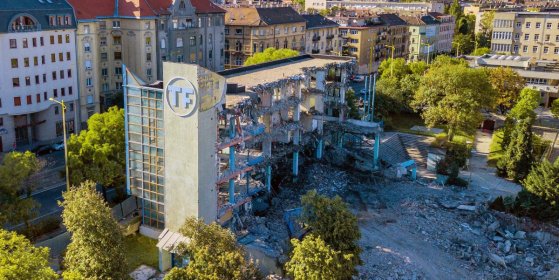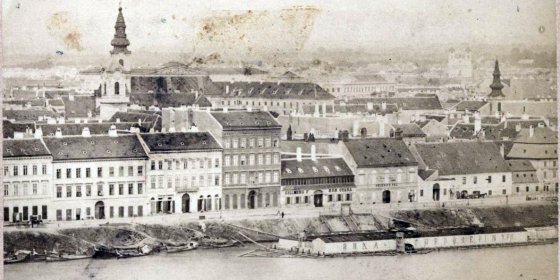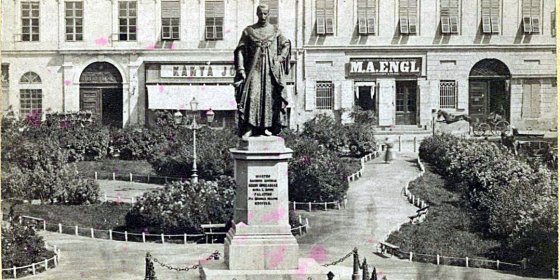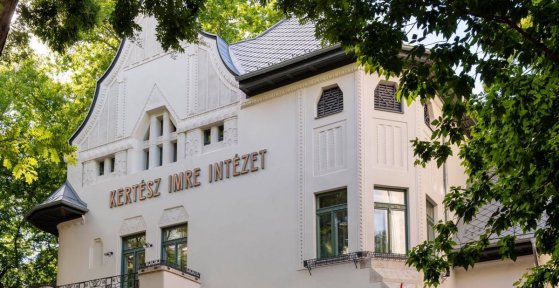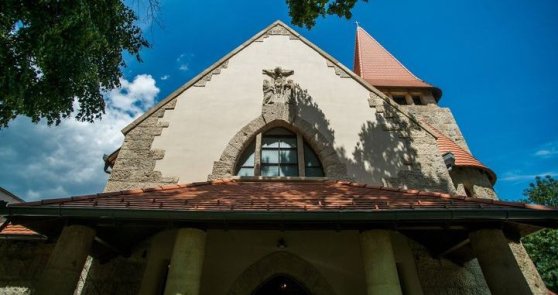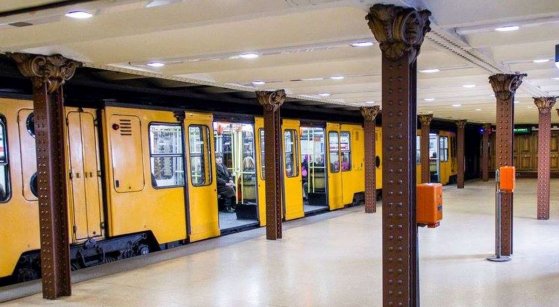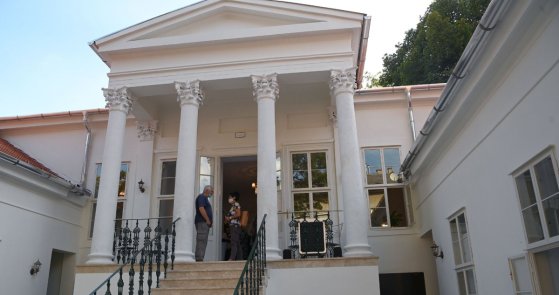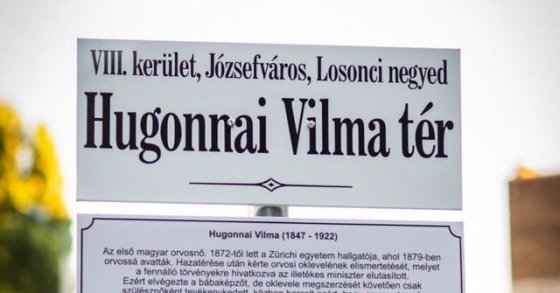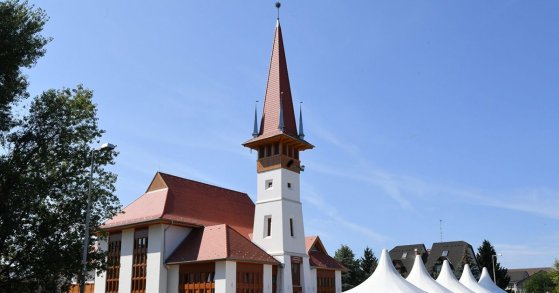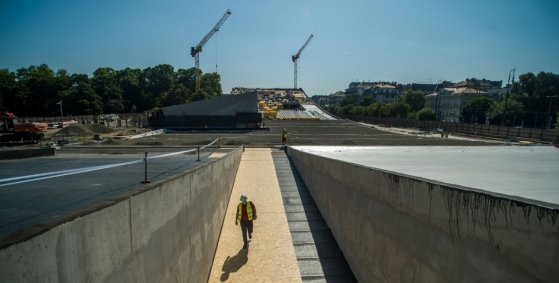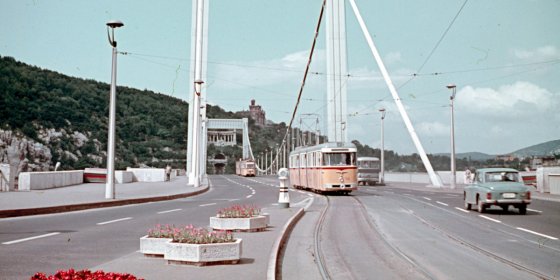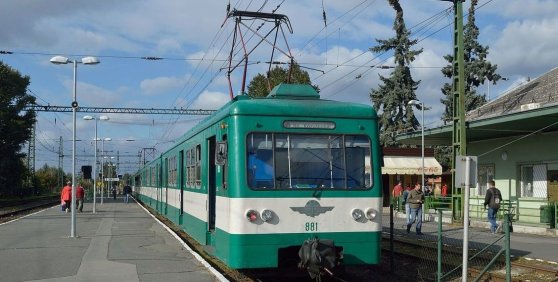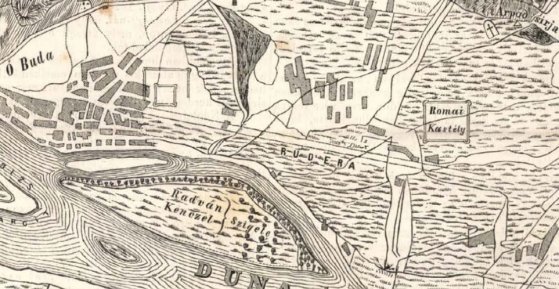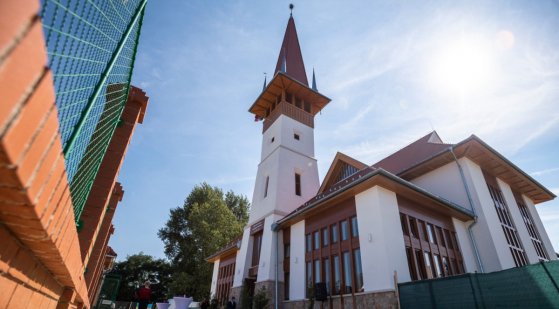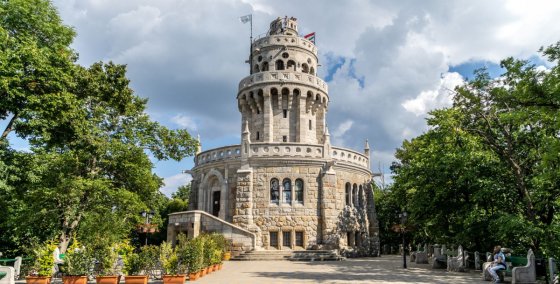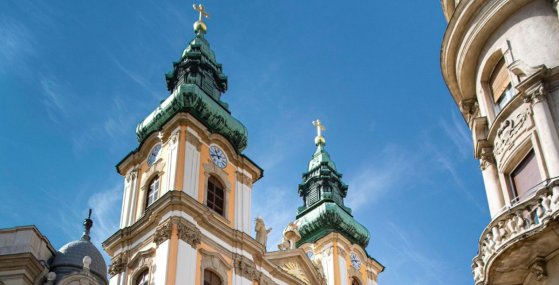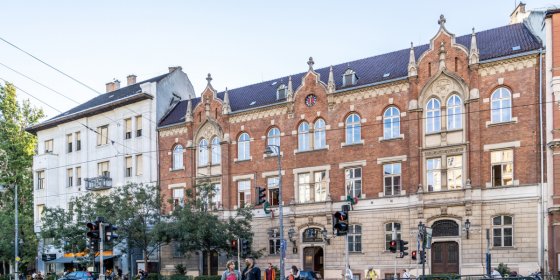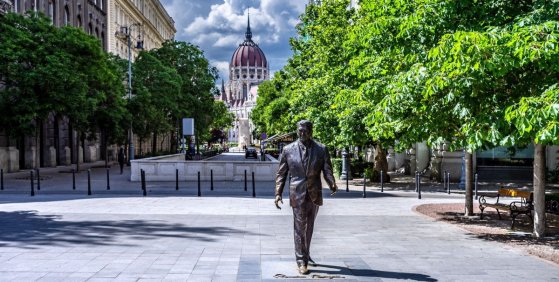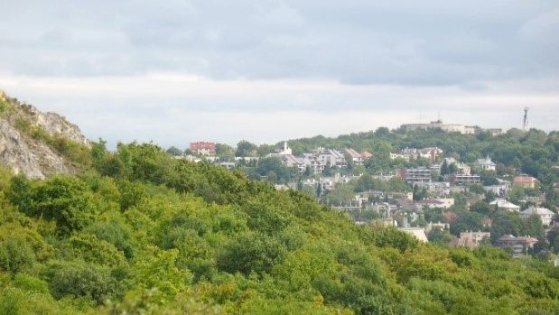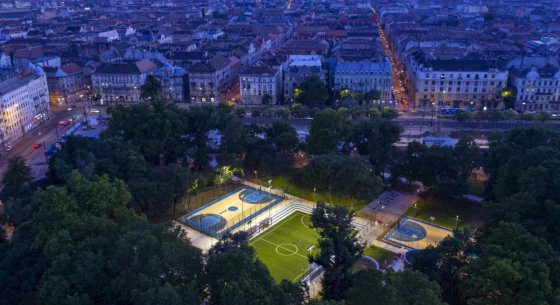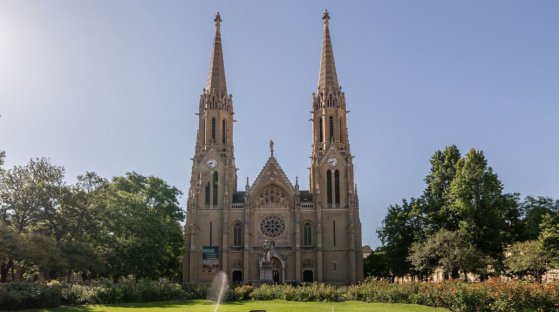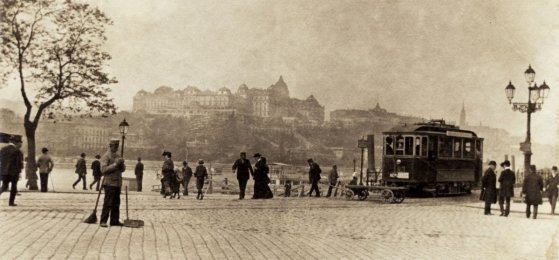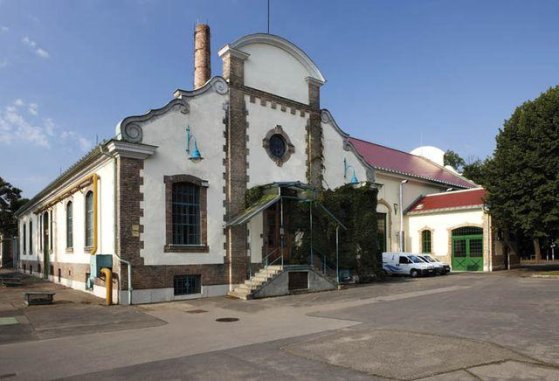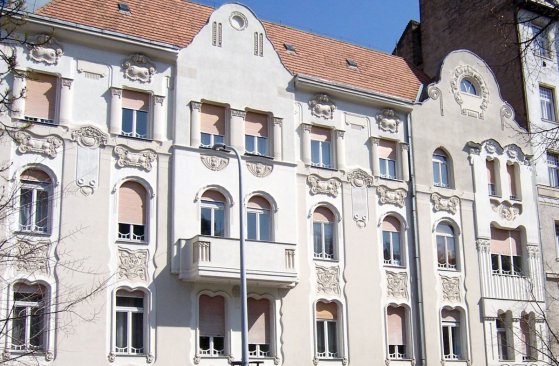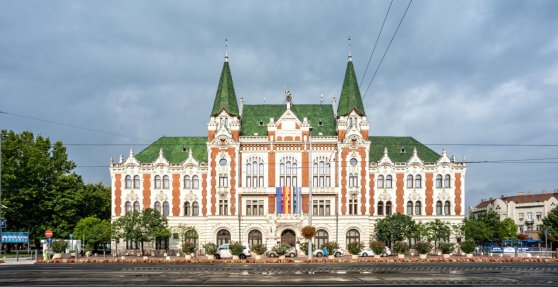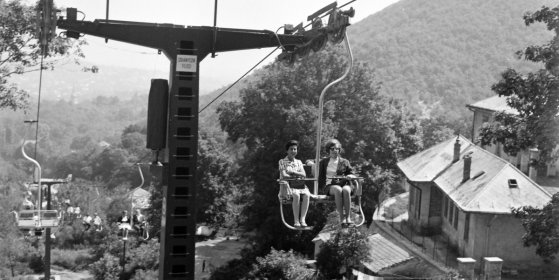 The „intertwined history” of the bridges and the city of Budapest
Which ideas and events have shaped the fate of bridges of Budapest and the cityscape? Alongside many other interesting facts, this question is also answered this newly published book by the Budapest City Archives, which introduces the history of bridges in Budapest.
The „intertwined history” of the bridges and the city of Budapest
Which ideas and events have shaped the fate of bridges of Budapest and the cityscape? Alongside many other interesting facts, this question is also answered this newly published book by the Budapest City Archives, which introduces the history of bridges in Budapest.
pestbuda.hu
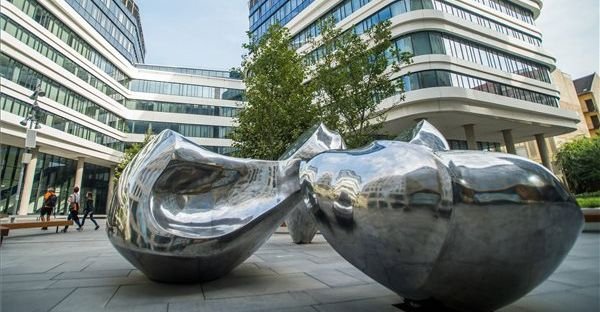 Reflective sculptures placed on Corvin Promenade
Reflective sculptures placed on Corvin Promenade
September 19, 2020 at 2:00 PM
A group of reflecting sculptures has been erected in the courtyard of an office building on Corvin Promenade as a result of a competition for young artists. The winner was selected from twenty-two entries with the cooperation of the University of Fine Arts.
Old building of the University of Physical Education being demolished
September 18, 2020 at 4:00 PM
The demolition of the university building on Alkotás Street began recently, as the development of the campus enclosed by Alkotás street – Győri Road – Kis János Altábornagy Road continues. The new campus will offer students and educators a proper university environment to work and study in.
Life underground – Significant population of Pest and Buda lived in cellars before the unification of the cities
September 18, 2020 at 10:00 AM
A census was conducted in Hungary in 1870, 150 years ago. It paints a stunning picture of Buda a Pest before the two cities were unified. Barely 200,000 people lived on the Pest side, and nearly 54 thousand on the Buda side. 15-thousand people lived in cellars, and 13,000 shared their rooms with at least ten other people. The census details how many doctors, writers, teachers lived in the cities, as well as how many unmarried or divorced women called the city home. Two centenarians lived in the city that was experiencing a massive development boom. It was a unique time, in which poverty and grandeur coexisted, and when the Renaissance revival homes so loved to this day were built.
The most Hungarian Habsburg moved to Buda 225 years ago
September 17, 2020 at 11:00 AM
Eventually serving as Palatine of Hungary for over 50 years, the young prince being raised in Florence would never have been expected to later be known as the Most Hungarian Habsburg. Palatine Joseph was only 19 when he moved to Budapest with much ceremony 225 years ago. He settled in the country, lived here with his wife and children, died here and was buried in the crypt of the Royal Palace in Buda Castle. His popularity was founded on the attention he paid to the prosperity of Buda and Pest.
New headquarters of the Imre Kertész institute completed
September 16, 2020 at 9:00 AM
The renovation of the Art Nouveau palace under 46 Benczúr Street has been completed. The building will serve as the headquarters of the Imre Kertész Institute which manages the literary legacy of the Noble laureate, and János Sziveri, and parts of the legacies of Arthur Koestler, György Petri and János Pilinszky.
Renovated Heart of Jesus Church blessed in Városmajor
September 14, 2020 at 5:00 PM
The renovation of the Heart of Jesus Church in Városmajor has been completed. The façade, interior and roof structure were replaced during the reconstruction. Designed by Aladár Árkay, the church served as a hall of worship for ten years and later became a scene of local community life.
Once a miracle of the National Millennium it was covered by graffiti a hundred years later
September 14, 2020 at 9:00 AM
Built under only 20 months, the first of its kind on the continent and tried by the King. The Millennium Underground Railway, commonly known as the kisföldalatti "small underground" may be Budapest's most likeable means of public transport. It most recent major renovation was finished 25 years ago.
Masses flocked to see the Concorde that landed at Ferihegy
September 13, 2020 at 11:00 AM
The Concorde may be the most impressive passenger aircraft ever created. Flying at twice the speed of sound, it could cross the Atlantic in only three hours. These miracles of a machine visited Budapest several times. The first landed at Ferihegy 35 years ago on 14 September 1985.
New synagogue opened in Buda
September 12, 2020 at 12:00 AM
New synagogue opened at the Alma Street orthodox Jewish Retirement Home in the 12th District
Square named after Vilma Hugonnai in Józsefváros
September 11, 2020 at 4:00 PM
The previously unnamed square that houses the monument to the doctors that died in World war I, in front of the Department of Obstetrics and Gynecology of Semmelweis University, has been named after Vilma Hugonnai, the first female Hungarian doctor.
Building of the communications authority to be expanded on Visegrádi Street
September 11, 2020 at 2:00 PM
The building complex of the National Media and Info-communication Authority is to be expanded with a new multifunctional wing. The five-story building with three floors underground and two above road level will house offices, meeting rooms, a high-capacity data centre and an event hall.
A visit to Budapest’s newest Reformed Church
September 11, 2020 at 9:00 AM
The Reformed Church opened in Soroksár on 5 September is reminiscent of the turreted towers of Churches in Kalotaszeg (Țara Călatei, Romania). While the eighth Reformed Church to be completed in Budapest since the fall of communism in Hungary way bear marks of long-standing traditions on its exterior, its interior is of a more modern inclination.
New building of the Museum of Ethnography reaches final height
September 10, 2020 at 3:00 PM
The new building for the Museum of Ethnography will be structurally complete this autumn and will open its doors to the public in 2022. The building is being constructed as part of the Liget Budapest Project on the site of the former car park on 56-osok Square.
A debate raging since the 19th century: Trams on Budapest bridges
September 10, 2020 at 11:00 AM
The question of running tracks across Margaret Bridge lead to a major debate during its construction, while trams only started running on Rákóczi bridge 20 years after its construction. Original plans for the bridge to be constructed near Galvani Street did not allocate rooms for trams. Nevertheless, it seems certain that guided transportation connections between Buda and Pest will remain for decades to come.
Suburban Railway extension to Kalvin Square to be completed in five years
September 9, 2020 at 4:00 PM
Three lines of Budapest's suburban railway system shall be completely renovated. As part of the project, the Ráckeve and Csepel lines will be extended underground to Kálvin Square
Frigyes Schulek designed a church to stand above Prince Árpád's final resting place
September 9, 2020 at 9:00 AM
Following the Hungarian National millennium of 1896, the country celebrated another millennium in 1907: the one-thousand-year anniversary of the death of Grand Prince Árpád, the ruler who led the conquest of the Carpathian Basin. Furthermore, the current ruler, Franz Joseph, also celebrated the 40th anniversary of his rule in the same year. A law passed to commemorate this double millennium stated that the Church built by King Saint Stephen, which had once stood on the outskirts of Óbuda where Prince Árpád was believed to be buried, should be rebuilt. Frigyes Schulek was commissioned to design the building.
Reformed Church opens in Soroksár
September 8, 2020 at 4:00 PM
The new church of the Soroksár–Újtelep Reformed Congregation opened on Dinnyehegyi Road in the 23rd District.
Queen Consort Elizabeth and the most beautiful lookout tower in Budapest
September 8, 2020 at 9:00 AM
The Elizabeth Lookout Tower atop János Hill in Budapest was opened with much ceremony 110 years ago. The tiered, cylindrical tower of snow-white limestone has since then become an unmatched staple of the Buda Hills, as it is visible from large swathes of the city. The present form of the lookout tower should be attributed to Frigyes Schulek. To honour the tower's anniversary, we have collected various images and stories from its past.
Renovated University Church reopened
September 7, 2020 at 5:00 PM
The University Church of the Nativity of the Blessed Virgin Mary in the 5th District has been renovated. As part of the process the statues of the baroque building were restored, its sacristy renovated, the floor tiles replaced, the heating and electrical system modernised and the copper cladding of the spires repaired.
A street of celebrities – Writers, painters and inventors once lived along Bartók Béla Road
September 7, 2020 at 1:00 PM
There is a part of Budapest where a car factory, a barracks, university halls of residence, and the entirety of Hungarian literary life in the inter-war years lived peacefully side-by-side. All within 100 metres of each other. A small section of a wonderful road with wonderful places: the stretch of Bartók Béla Road between Szent Gellért [Saint Gerard] Square and the Körtér.
Statue of George H. W. Bush to be erected beside statue of Ronald Reagan on Szabadság Square
September 7, 2020 at 10:00 AM
A statue of President George H. W. Bush is to be erected in Budapest on Szabadság [Freedom] Square, alongside an existing statue of President Ronald Reagan. The monument will be inaugurated on the Hungarian National Holiday, 23 October to commemorate the 30-year anniversary of the fall of communism in Central and Eastern Europe.
Walking paths on Sas Hill to be renovated
September 5, 2020 at 4:00 PM
The Danube–Ipoly National Park is carrying out development work on Sas Hill. Alongside the pruning of shrubs and planting of saplings, walk paths are to be renovated, new tables and benches, information boards, nesting spots and bird feeders built.
New sports centre in City Park completed and opened to the public
September 3, 2020 at 10:00 AM
The City Parks Sports Centre has been completed. Located in the south-eastern area of the park – near the intersection of Ajtósi Dürer Way and Dózsa György Road, the thirty-six-thousand square metre accessible sports centre contains football pitches, basketball courts, climbing walls and ping pong and teqball tables.
One of the most beautiful churches in Budapest
August 30, 2020 at 9:00 AM
The parish church of St. Elizabeth of Hungary located on Rózsák Square, in the 7th District, will also be a venue of the International Eucharistic Congress next year. The building with a capacity of 2,560 people is a masterpiece by Imre Steindl, the designer of the Parliament, and one of the largest neo-Gothic churches in Budapest.
Clean Budapest – The city has been cleaned regularly for 125 years
August 28, 2020 at 9:00 AM
The inhabitants of Pest and Buda used to carry garbage to rubbish pits or simply drop it on the banks of the Danube. Because of this, there was often an unbearable stench in the two cities. All this changed radically 125 years ago when an office was established in the capital to clean the roads of Budapest and collect rubbish.
Water meters were installed 100 years ago to reduce water waste
August 25, 2020 at 1:00 PM
It is hard to imagine today that drinking water from the tap was not always a basic service. Mihály Kajlinger, born 160 years ago, has indisputable merit in the organisation and construction of Budapest's water supply. His name is associated with the plans for the capital's large sewage pumping station, sewerage, and water supply network, but water consumption meters were also introduced at his suggestion to curb water waste. His main work, the waterworks of Káposztásmegyer, was the most beautiful and modern waterworks in contemporary Europe.
New Drug Research Centre to open next year in former hospital building
August 24, 2020 at 9:00 AM
The capital has few hospital buildings opened more than a hundred years ago that do not need to be thoroughly renovated, remodelled or modernised. There was also a period, not so long ago, when such institutions were closed rather than maintained. But the list of empty unused buildings also goes on and on, as they await new use of demolition. Fortunately, there are already examples of healthcare buildings being renovated without major changes in function. An example is the former Schöpf-Merei Ágoston Hospital.
Újpest City Hall 120 years old
August 22, 2020 at 9:00 AM
One of the symbols of Újpest, the town hall, which was inaugurated 120 years ago, on 21 August 1900, was designed by the outstanding architects of the age, Ármin Hegedűs and Henrik Böhm. Originally a town hall and then city hall from 1907, the historic building, which bears Art Nouveau features, is still in the service of the local population.
The bells of Saint Stephen's Basilica – Hungarian and German masterpieces
August 21, 2020 at 9:00 AM
The historical value of the former and present bells in Saint Stephen's Basilica in Budapest is significant in terms of ecclesiastical, industrial and national history. Today’s large bell was donated by the German people in 1990 and was made by Perner in Passau. The bell was consecrated on 20 August 1990, thirty years ago. It is the largest bell in Hungary today.
Brides, stuntmen and sandbags have travelled on the Chairlift – Budapest's most unique means of public transport
August 19, 2020 at 10:00 AM
The János Hill chairlift is one of Budapest's most interesting means of transport and has been serving the city since 19 August 1970. There are several interesting facts connected to it. Few know that the first “passengers” on the chair lift were sandbags. A wedding was once held up in the air, and the Trapper jeans brand also shot a commercial on the lift, with a stuntman travelling above the city standing up.
More articles
 The „intertwined history” of the bridges and the city of Budapest
Which ideas and events have shaped the fate of bridges of Budapest and the cityscape? Alongside many other interesting facts, this question is also answered this newly published book by the Budapest City Archives, which introduces the history of bridges in Budapest.
The „intertwined history” of the bridges and the city of Budapest
Which ideas and events have shaped the fate of bridges of Budapest and the cityscape? Alongside many other interesting facts, this question is also answered this newly published book by the Budapest City Archives, which introduces the history of bridges in Budapest.
 The Bridge Report, which brought a turning point in the history of Budapest
A travel report that changed the history of Pest and Buda, as well as Hungary. The little book contributed to the change of half a thousand years of legal customs and the implementation of an investment of unprecedented size and technical quality. This book was The Bridge Report [Hídjelentés in Hungarian].
The Bridge Report, which brought a turning point in the history of Budapest
A travel report that changed the history of Pest and Buda, as well as Hungary. The little book contributed to the change of half a thousand years of legal customs and the implementation of an investment of unprecedented size and technical quality. This book was The Bridge Report [Hídjelentés in Hungarian].
 Drama on the university wall - The heroic monument was planned 95 years ago
In the constant hustle and bustle of the Egyetem Square in Pest, the students may not even notice the monument that decorates the short section of wall between the church and the central building of ELTE. However, it commemorates their predecessors, the heroes who fought for their country in World War I, and those who heroically helped them. The first design of the dramatically collapsing soldier was born in 1928, ninety-five years ago.
Drama on the university wall - The heroic monument was planned 95 years ago
In the constant hustle and bustle of the Egyetem Square in Pest, the students may not even notice the monument that decorates the short section of wall between the church and the central building of ELTE. However, it commemorates their predecessors, the heroes who fought for their country in World War I, and those who heroically helped them. The first design of the dramatically collapsing soldier was born in 1928, ninety-five years ago.

